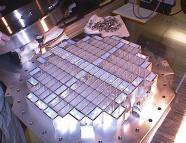 |
|
| Aerogel Dust Collector
under construction.
|
|
The aerogel aboard the Stardust Spacecraft is
fitted into a "tennis racket" shaped
collector. This is unfolded from the protective
Sample Return Capsule to expose it to space during
flight. One side of the collector will be faced
towards the particles in Comet Wild 2, while the
reverse, or B side, will be turned to face the
streams of interstellar dust encountered during
its journey.
When hypervelocity particles are captured in aerogel
they produce narrow cone-shaped tracks that are
hollow, and can easily be seen in the highly transparent
aerogel by using a stereomicroscope. This cone
is largest at the point of entry, and the particle
is held intact at the point of the cone. This
provides a method for determining which direction
the dust came from, and is the basis of the approach
of using single slabs of aerogel to collect both
cometary and interstellar dust from both sides.
After the encounter with Comet Wild 2, the aerogel
collector will be retracted into the Sample Return
Capsule (SRC) and returned to Earth for detailed
analysis by scientists at the NASAs Johnson Space
Center.
|
